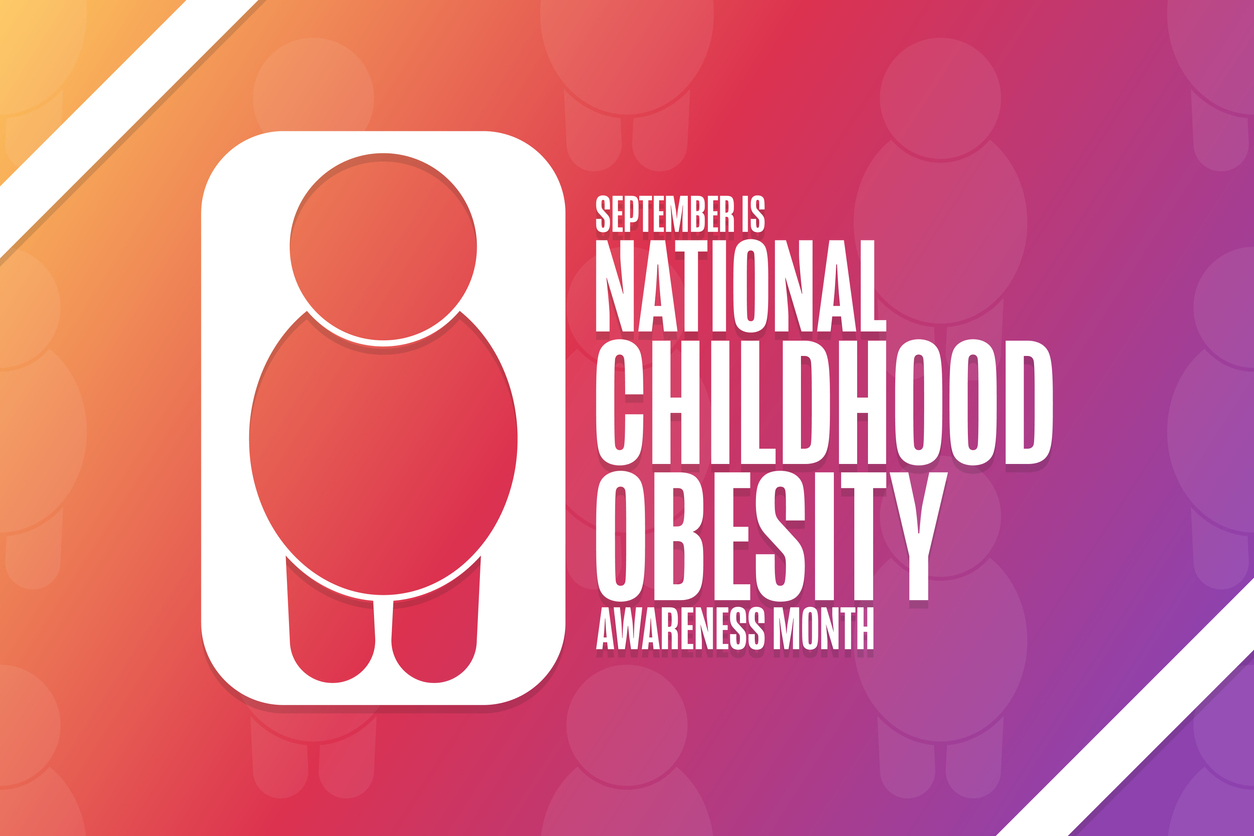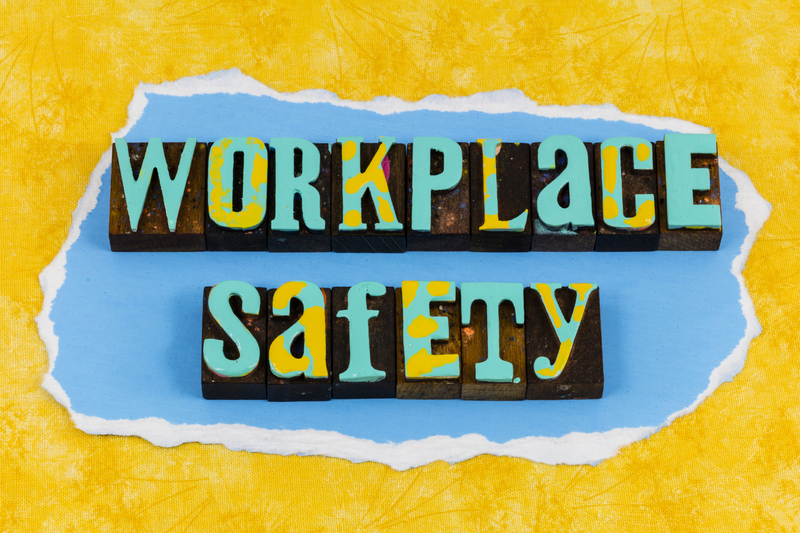Category: Insurance
Play an Active Role to Prevent Childhood Obesity
August 30, 2022

National Childhood Obesity Awareness Month, observed in September, is dedicated to educating children and their families on how to prevent childhood obesity. Parents, teachers, and caregivers of young children are continuously challenged to find ways to prevent childhood obesity.
Obesity is defined as a body mass index (BMI) at or above the 95th percentile by the Centers for Disease Prevention and Control (CDC) sex-specific BMI-for-age growth charts. Childhood obesity is a serious problem in the United States where one in five children and adolescents are affected. Some groups of children are more impacted than others, but all children are at risk of gaining weight that is higher than what is considered healthy.
Obesity is a complex disease with many contributing factors including genetics, eating patterns, physical activity levels, and sleep routines. Societal and community factors also matter— childcare and school environments, neighborhood design, access to health, affordable foods and beverages, and connections to safe and convenient places for physical activity affect the ability of children to make healthy choices.
Strategies to Prevent Obesity
As a parent or a caregiver, you can help prevent obesity at home; healthcare systems can help families prevent and manage childhood obesity, and communities can use strategies to support a healthy, active lifestyle for all.
Compared to children with healthy weight, children who are overweight or obese are at a higher risk for asthma, sleep apnea, bone and joint problems, type 2 diabetes, and heart disease.
There are many ways parents and caregivers can help children have a healthy weight and set up lifelong healthy habits at home.
Healthy Eating Patterns
Adopting healthy eating patterns as a family helps children reach and maintain a healthy weight as they age. Eating a variety of vegetables and fruits, whole grains, lean protein foods, and low-fat and fat-free dairy products and following nutrition guidelines sets your family up for optimal health.
Help your children get the nutrients they need by making half their plate fruits and vegetables. Help kids rethink their drinks by replacing sugary drinks, such as soda, fruit drinks, and flavored milk, with water, 100 percent juice, or plain low-fat milk.
Movement Solutions
Physically active youth have stronger muscles and bones, better cardiovascular fitness, and lower body fat than those who are inactive.
Help your children move more and meet the Physical Activity Guidelines for Americans by making it a family affair. Walking the family pet before and after school, riding bikes, and having races in the yard all count toward physical activity. Active chores, such as washing the car, vacuuming a room, or raking leaves, also engage children in worthwhile physical activities.
Consistent Sleep Routines
Good sleep helps prevent type 2 diabetes, obesity, injuries, poor mental health, and problems with attention and behavior. Kids who don’t get enough sleep are at risk for unhealthy weight gain. Researchers are still trying to learn how sleep is linked to weight gain. Some reasons might include causing a child to eat more or to be less physically active because of a lack of energy.
CDC provides guidelines for the number of hours needed to sleep by age group. Preschoolers need 11–13 hours of sleep per day, including naps. Children 6–12 years old need 9–12 hours of uninterrupted sleep a night, and youth 13–18 need 8–10 hours. Sticking to a consistent sleep schedule, including on weekends, can help children sleep better.
Screen Time vs. Family Time
In young people, too much screen time can lead to poor sleep, weight gain, lower grades in school, and poor mental health. Reducing screen time can free up time for family activities and can remove tendencies to eat unhealthy food.
Turning screens off an hour before bed and removing electronic devices from children’s bedrooms can help reduce screen time and improve sleep. The American Academy of Pediatrics recommends creating a family media plan with examples of how to reduce screen time.
Healthcare Providers’ Recommendations
Talk to your child’s healthcare provider if you’re concerned about potential health risks associated with excess weight. Children with obesity are more likely to have type 2 diabetes, risk factors for heart disease such as high blood pressure and high cholesterol, muscle and joint problems, and fatty liver disease. Schedule annual physical checkups to routinely check on these medical conditions and to measure a child’s weight and height and plot them on growth charts to calculate BMI and assess patterns.
InsureYouKnow.org
At insureyouknow.org, keep a record of your child’s health insurance coverage, results from their annual wellness check-up, and follow-up recommendations to keep your child as healthy and happy as possible.
Calling All Employers to Support Mental Health
August 15, 2022

According to the American Psychological Association’s (APA) 2022 Work and Well-being Survey, eight in 10 U.S. workers say they would prefer to work for companies that provide support for mental health concerns. Of the employees surveyed, 71 percent believe employers are more concerned about the mental health of their employees now than in the past.
When asked to select from a list of a dozen possible supports that they would like to see employers offer, flexible work hours were the most chosen support at 41 percent of workers, followed by a workplace culture that respects time off at 34 percent, the ability to work remotely at 33 percent, and a four-day work week at 31 percent.
Potential Benefits of Supporting Mental Health
- Increased productivity: Research shows that nearly 86 percent of employees treated for depression report improved work performance. Also, treatment of depression has been shown to reduce absenteeism and presenteeism (lost productivity occurring when employees are not fully functioning in the workplace because of an illness, injury, or other condition) by 40 to 60 percent.
- Increased retention: In a 2019 survey of more than 1,500 employees nationwide, more than a third of the respondents said they had left a job due at least in part to mental health. Of these, 59 percent said mental health was the primary reason.
- Decreased health care and disability costs: According to the National Alliance on Mental Illness, rates of cardiovascular and metabolic diseases are twice as high in adults with serious mental illness. The connection between physical health and mental health prompted the American Heart Association to release a report called Mental Health: A Workforce Crisis. It urges employers to provide comprehensive programs for the prevention and treatment of mental illness. The report found that the cost of doing nothing is higher than investing in evidence-based prevention and treatment.
Ways to Support Employee Mental Health
With these findings in mind, employees should consider implementing the following five ways to support employee mental health:
1. Understand how mental health impacts your employees.
- Make mental health training mandatory for your company’s leaders to help them be more aware of and invested in this aspect of their employees’ well-being.
- Train managers on what to do if they see signs of emotional distress or substance abuse.
- Use mental health calculators to estimate the prevalence and associated costs of untreated depression and alcohol and substance abuse at your workplace.
- Consider using surveys such as the Work Limitations Questionnaire and the Brief Job Stress Questionnaire to measure how your employees’ health and stress levels affect their productivity.
2. Include mental health coverage as part of your health care plan.
- Learn about the Mental Health Parity and Addiction Equity Act. It requires insurance coverage for mental health conditions, including substance use disorders, to be no more restrictive than insurance coverage for other medical conditions.
- Avoid plans that offer “phantom” mental health coverage. And find out how many psychologists and psychiatrists are in-network.
- Provide a health savings account (HSA) to help offset out-of-pocket costs.
3. Establish an employee assistance program (EAP).
Many companies use an employee assistance program (EAP) to support workplace mental health. While some employees may be reluctant to use this resource due to fear of stigma, shame, and lack of understanding about how these confidential programs work, you can take the following actions to increase EAP usage:
- Provide direct access to mental health professionals via phone or in person.
- Offer this resource to employees as well as to their immediate family members.
- Make it easy for employees to know with whom to talk or where to go to access mental health resources.
- Emphasize that your EAP can be accessed confidentially and free of charge.
4. Use communication to reduce stigma and increase access to mental health resources.
- Don’t wait until open enrollment to mention mental health benefits and community resources. Promote them frequently, such as in monthly newsletters.
- Ensure that your executives mention emotional well-being every time they talk about recruiting talent and building an inclusive culture that helps employees bring their best selves to work.
- Offer workshops so employees can learn more about mental health and resilience.
5. Promote well-being.
- Build as much flexibility as possible into all employees’ schedules.
- Offer access to apps that can help with sleep and stress reduction.
- Consider offering a meditation room, mindfulness training, or yoga classes at work.
- Encourage employees to use their vacation time. Some companies do this by limiting the number of vacation days employees can roll over into the next year.
- Provide accommodations and develop a return-to-work process so that employees who need to take a leave of absence because of a mental health issue feel supported when they come back.
And finally, create opportunities for employees to build connections with one another, such as through social events, affinity groups, and social media platforms.
APA Survey Conclusions
The APA survey shows that the U.S. currently has a workforce that seeks improvements to mental health support at work. While the pandemic may have exacerbated stressors among workers, particularly those in marginalized communities, it also provided an opportunity for employers to take action to prioritize employee well-being.
InsureYouKnow.org
Whether you are an employer or an employee, you can support mental health coverage as part of your company’s health care plan. At insureyouknow.org, you can document healthcare benefits that cover your mental health concerns, a list of the healthcare providers with whom you visit, and a record of prescriptions you take for physical and mental health issues.
In August, Embrace National Wellness Month
July 14, 2022

When you think about “wellness,” being physically fit may come first to your mind. During National Wellness Month in August, if you also focus on self-care, managing stress, and adopting healthy routines, you can establish lifestyle changes and add long-lasting habits to your list of wellness goals.
Practicing Self-Care
At Chopra.com, you’ll learn that self-care is simply one of the best medicines for managing stress. Self-care means the daily, weekly, and lifelong behaviors, actions, and thoughts you take to preserve or improve your long-term health and happiness.
You can make small self-care changes, including:
- Increase your water intake.
- Add more fruits and vegetables to your diet.
- Monitor your sleep and make adjustments for better sleep habits.
- Join a yoga, walking, or aerobics class.
- Learn to meditate and practice it daily.
These small steps can lead to many more healthy habits in your lifestyle.
Managing Stress
There are many healthy ways to manage stress, including:
- Recognize the things you can’t change.
- Avoid stressful situations.
- Get exercise.
- Change your outlook.
- Do something you enjoy.
- Learn new ways to relax.
- Connect with loved ones.
- Get enough sleep.
- Maintain a healthy diet.
- Learn to say no.
Adopting Healthy Routines
Physical activity is any body movement that works your muscles and requires more energy than resting. Walking, running, dancing, swimming, yoga, and gardening are a few examples of physical activity.
Being active can:
- Protect your heart.
- Improve blood flow.
- Lower blood pressure and cholesterol levels.
- Give you more stamina and the ability to cope with stress.
If you’re inactive, you’re nearly twice as likely to develop heart disease than if you’re active. Learn more about the benefits of physical activity on the National Heart, Lung, and Blood Institute website.
Keeping Track of Your Health
When you go to your healthcare provider for an annual wellness check or during the year for other medical concerns, you probably receive follow-up messages about lab test results, diagnoses, or medications recommended. Your healthcare provider keeps your medical record on file but it’s a good idea for you to maintain your personal health record.
What kind of information should you put in a personal health record? You could start with:
- Copies of your health insurance cards and vaccination records.
- Your name, birth date, blood type, and emergency contact information.
- Date of last physical.
- Dates and results of tests and screenings.
- Major illnesses and surgeries, with dates.
- A list of your medicines and supplements, the dosages, and the length you’ve taken them.
- Any allergies.
- Any chronic diseases.
- Any history of illnesses in your family.
InsureYouKnow.org
During National Wellness Month, you can save your personal health record at insureyouknow.org and keep updating it after each visit to your healthcare provider or if you have any changes in your health conditions or prescriptions.
We’re Having a Heatwave!
June 30, 2022

When you venture out of your air-conditioned comfort zone, do you immediately think, “It’s hot as Hades” outside? Extreme heat is the most dangerous type of severe-weather event in the United States. It’s easy to talk about the weather and resolve not to be able to do anything about it but you can take action to prepare for an extreme heat event. Learn what to do before, during, and after a heatwave to be safe and healthy.
Heat Emergencies
There are three types of heat emergencies: heat cramps caused by loss of salt, heat exhaustion caused by dehydration, and heat stroke. If you are experiencing any of these symptoms, get out of the heat, lie down, apply cool compresses, elevate your feet, drink fluids, and use a fan to blow cool air. Get medical help if needed.
Heat Exhaustion and Heatstroke
Heat exhaustion occurs when your body gets too hot. Untreated, this condition can lead to heatstroke when your internal temperature reaches at least 104°F. Heatstroke is much more serious than heat exhaustion. It can cause shock, organ failure, or brain damage. In extreme cases, heatstroke can kill you.
Symptoms of heat exhaustion are:
- Muscle cramps
- Heavy sweating
- Pale or cold skin
- Weakness and/or confusion
- Dizziness
- Headache
- Nausea or vomiting
- Fast heartbeat
- Dark-colored urine, which indicates dehydration
In addition to these symptoms, warning signs of heatstroke also include:
- Fever of 104°F or higher
- Flushed or red skin
- Lack of sweating
- Trouble breathing
- Fainting
- Seizures
Prevention of Heat Exhaustion and Heatstroke
There are many things you can do to prevent heat-related illnesses. Babies, children, and elderly people are more sensitive to heat and require extra attention. You are at greater risk if you are ill, obese, or have heart disease. People who work outside or in a hot setting are also at risk of heat exhaustion and heatstroke.
If possible, avoid going outside when the temperature and heat index are high. Stay indoors in air-conditioned areas. If you do need to go outside, take the following precautions.
- Wear lightweight, light-colored, loose-fitting clothing.
- Protect yourself from the sun by wearing a hat or using an umbrella.
- Use sunscreen with a sun protection factor (SPF) of 15 or higher.
- Drink plenty of water throughout the day. Dehydration and lack of salt contribute to heat-related illnesses. Some sports drinks can help replenish the salt in your body lost through sweating. Drink water or other fluids every 15 to 20 minutes, even if you don’t feel thirsty. If your urine is clear, you’re probably drinking enough fluids. Dark-colored urine is a sign that you’re dehydrated.
- Avoid alcohol and limit drinks that contain caffeine, such as tea, coffee, and soda.
- Schedule outdoor activities for cooler times of the day—before 10 a.m. and after 6 p.m.
- Take frequent breaks from the heat and outdoor activities.
- Do not stay or leave a child in your car when it is hot outside. Even if you open the windows, the intense heat can be extremely dangerous.
Certain medications can put you in danger of heatstroke. They affect the way your body reacts to heat and include some antibiotics, allergy medicines, and drugs used to manage blood pressure, cholesterol, mental health disorders, and heart disease. Talk to your doctor if you take any of these or have an ongoing health problem.
Treatment for Heat Exhaustion and Heatstroke
If you or someone near you experiences heat exhaustion, treat symptoms in the following ways.
- Get out of the heat quickly and into a cool place, or at least in a shaded area.
- Lie down and elevate your legs to get the blood flowing to your heart.
- Take off any tight or extra clothing.
- Apply cool towels to your skin or take a cool bath. This will help regulate and lower your internal body temperature.
- Drink fluids, such as water or a sports drink. Sip slowly—don’t guzzle liquids. Don’t drink fluids with caffeine or alcohol.
Call 911 if:
- Symptoms don’t improve or an affected person still has a fever of 102°F after 30 minutes of initial treatment.
- The person goes into shock, faints, or has seizures.
- The person is not breathing; begin CPR right away to try and revive them.
Living With Heat Exhaustion and Heatstroke
After you’ve had heat exhaustion or heatstroke, you’ll be sensitive to heat. This can last for about a week. It’s important to rest and let your body recover while you avoid hot weather and exercise. Ask your doctor when it’s safe to return to your normal activities.
InsureYouKnow.org
At insureyouknow.org you can keep a record of your prescriptions known to exacerbate heat-related conditions. If you do experience an emergency during a heat wave, you’ll also be able to quickly access your health insurance credentials online to help healthcare providers effectively treat you. After you recover, be sure to take recommended precautions whenever you need to endure hot weather.
College Graduates’ Guide to Insurance
May 31, 2022

Congratulations to college graduates everywhere as the graduation season kicks off in 2022! Homework continues, however, as grads meet the challenges presented by their next decisions—changing their residences, jobs, and insurance coverages. Even though this last item may not be as exciting as finding a new place to live or pursuing a lucrative career opportunity, the following options in insurance coverages are important issues that new college grads need to address.
Health Insurance
Since the passage of the Affordable Care Act (ACA), choosing new coverage—or holding on to existing coverage—has been much easier for college graduates who may decide to:
1. Remain on a parent’s insurance plan
Before the ACA was enacted, it was common for health insurance plans to drop dependents as soon as they graduated from college. But the ACA requires almost all health plans that offer dependent coverage to allow young adults to remain on a parent’s plan until they turn 26. So, for young adults covered under a parent’s plan, graduating from college no longer requires them to quickly find new health insurance.
2. Purchase a short-term plan
Short-term health insurance is a potential alternative for college grads who need temporary coverage to tide them over until another policy kicks in. Even for grads who have a job lined up right away, employers often have a waiting period before health insurance coverage is available to new hires. Short-term plans can be purchased at any time of the year, with immediate effective dates available.
3. Buy an ACA-compliant individual plan
For new grads who want a more robust, ACA-compliant plan that covers the essential health benefits and pre-existing conditions, a plan purchased through the state health insurance exchange is likely to be an ideal solution. For more information about marketplace insurance, visit www.healthcare.gov.
4. Check Medicaid eligibility
In 38 states, Medicaid has been expanded to cover all adults with income up to 138 percent of the poverty level. In 2022, that’s $18,754 for a single individual, except in Alaska and Hawaii where the limit is higher. Medicaid enrollment is available year-round and coverage includes pre-existing conditions. In most cases, there are no premiums. For a new grad living in a state where Medicaid has been expanded, this could be a perfect solution during the weeks or months that it might take to find a job after graduation.
5. Get coverage through a new employer
College grads may be able to enroll in group coverage at their new jobs. Employer-sponsored health insurance generally offers substantial benefits, and employers typically pay a large portion of the premiums. Employee contributions are paid through payroll deductions. Participants also may be eligible to enroll in a Health Savings Account that minimizes the financial impact of out-of-pocket medical expenses.
Renters’ and Homeowners’ Insurance Policies
Before graduation, college students probably lived in a dorm room or shared housing with other students. Now, it may be time for them to relocate to their first apartment, condo, or house.
Renters need to understand that their landlord’s insurance doesn’t cover their belongings. Suppose renters experience an unforeseen situation, including burglary, stormy weather that causes a leaky roof to destroy their furnishings, or a fire that creates smoke damage. In these scenarios, they could be protected by renters’ insurance.
Homeowners’ insurance policies, available to college grads buying their first condos or houses, combine several types of coverage, including dwelling, personal property, other structures, loss of use, personal liability, and medical payments into one policy,
It’s a good idea for renters and homebuyers to create a spreadsheet with an inventory of the contents of their residences, placing approximate values on their belongings.
Auto Insurance
Upon completing college, grads may be ready to buy a new car that requires upgrading their auto insurance, especially if they had been previously covered under their parents’ policy. Personal auto insurance is a package policy providing four coverages—liability, medical payments, uninsured and underinsured motorist, and physical damage.
Life Insurance
Unless a college grad is married or has individuals, such as a child or an aging parent dependent on their income, life insurance may not be needed right away. However, if young adults are single, healthy, and in a family with a good health history, they may be at an insurability peak and would benefit from the best rates on life insurance.
InsureYouKnow.org
College graduation prompts a transition from a school-based existence to one replete with adult responsibilities, including the need to put insurance policies in place. By preparing for the unforeseen future, college grads who do their homework on insurance options and keep copies of policies, inventories of their belongings, and records of any claims submitted at insureyouknow.org, can begin living their lives to the fullest.
Shopping for SHOP Coverage
May 15, 2022

Signed into law in 2010, the Affordable Care Act changed many regulations affecting small businesses and insurance. The law established the Small Business Health Options Program (SHOP) for small employers —generally those with 1–50 employees—who want to provide health and dental coverage to their employees affordably, flexibly, and conveniently.
Qualifications to provide SHOP coverage
Find out on the HealthCare.gov website if your business or non-profit organization qualifies for SHOP by meeting the following four requirements:
1. You have 1-50 full-time equivalent employees (FTEs)
- Use the FTE Calculator to see if you qualify. Note: To qualify for SHOP, you must have at least one FTE employee other than owners, spouses, and family members of owners and partners.
2. You offer coverage to all full-time employees—generally, workers averaging 30 or more hours per week
- You don’t have to offer coverage to part-time employees—those averaging fewer than 30 hours per week—or seasonal workers.
3. You enroll at least 70 percent of the employees to whom you offer insurance
- Employees with other health coverage aren’t counted as rejecting your offer.
- Use the SHOP Minimum Participation Rate Calculator to see how many of your employees must accept.
- Some states have different minimum participation requirements. See if this affects you.
- If you don’t meet your minimum participation requirement, you can enroll between November 15-December 15 any year. During this time, the participation requirement isn’t enforced.
4. You have an office or employee work site within the state whose SHOP you want to use
- Visit this page, select your state, and see how to access SHOP insurance in your state.
- See what to do if your business operates in multiple states.
- If eligible, you don’t have to wait for an open enrollment period. You can start offering SHOP coverage to your employees any time of year.
Reasons to offer SHOP coverage
- SHOP insurance gives you choice and flexibility to:
- Offer your employees one plan or let them choose from multiple plans.
- Offer only health coverage, only dental coverage, or both.
- Choose how much you pay toward your employees’ premiums and whether to offer coverage to their dependents.
- Decide how long new employees must wait before enrolling.
- You can get the information you need in one location. You can make an informed decision about your SHOP insurance options with the tools at HealthCare.gov where you can compare plans and prices and find out if you qualify for SHOP.
- You can use your current SHOP-registered agent or broker or find an agent or broker in your area to help you enroll in coverage.
- You may be able to get the Small Business Health Care Tax Credit. Enrolling in SHOP insurance is generally the only way for eligible small employers to take advantage of the Small Business Health Care Tax Credit. You may qualify if you have fewer than 25 FTE employees making an average of about $56,000 or less. See how much your business could save. Updated IRC guidelines for small business health care tax credit and the SHOP marketplace can inform you if you are a small employer.
InsureYouKnow.org
Whether you are an employer or an employee in a small business, you may find it helpful to review SHOP coverage how-to guides, fact sheets, tools, and other resources. After making SHOP health insurance decisions, you can keep your records about the best plan for you and its costs, benefits, and features at insureyouknow.org.
Before You Take a Deep Breath Outside This Spring
April 15, 2022

You’ve got cabin fever and spring weather is beckoning you to enjoy the great outdoors. Before you venture forth–even if it’s just to your backyard—curtail allergic reactions to pollen that may cause you to have hay fever and start to sniffle and sneeze.
Causes and symptoms
The biggest spring allergy trigger is pollen from trees, grasses, and weeds that release tiny grains into the air to fertilize other plants. When these particles get into the nose of someone who’s allergic, they send the body’s defenses into high gear.
The immune system mistakenly sees the pollen as a danger and releases antibodies that attack the allergens leading to the release of histamines into the blood. Histamines are chemicals that trigger a runny nose, itchy eyes, dark circles under your eyes, and other symptoms that are familiar if you have allergies.
Pollen counts tend to be particularly high on breezy days when the wind picks up sneeze-inducing grains and carries them through the air. Rainy days wash away allergens.
Being inside may protect you from windblown pollen, but other seasonal triggers, such as mold and dust mites, can be prevalent inside your house and cause allergic reactions.
Diagnosis
Start with your primary physician who may refer you to an allergist for tests. An allergy specialist may give you a skin test, which involves either pricking the surface of the skin with a tiny amount of allergen or injecting a tiny sample of a diluted allergen under the skin of your arm or back. If you’re allergic to the substance, a small red bump (called a wheal or hive) will form. You may also undergo a blood test to detect and measure the allergen-specific antibodies in your blood.
Treatments
Many over-the-counter and prescription drugs can ease the symptoms of allergies. They include:
- Antihistamines reduce sneezing, sniffling, and itching by lowering the amount of histamine in your body.
- Decongestants shrink blood vessels in the nasal passageways to relieve congestion and swelling.
- Antihistamine/decongestant combos combine the effects of both drugs.
- Nasal spray decongestants relieve congestion and may clear clogged nasal passages faster than oral decongestants without some of the side effects.
- Steroid nasal sprays ease inflammation and are the preferred initial treatment.
- Eye drops relieve itchy, watery eyes.
- Immunotherapy gives you gradually increasing doses of the allergen until your body can handle it. The treatment can relieve your symptoms for a longer time than other types of allergy medications. Although it doesn’t work for everyone, it can stave off some people’s symptoms for a few years.
If you feel like you need over-the-counter antihistamines and decongestants for more than a few days, ask your doctor to recommend an effective regimen, which may include:
- Prescription medications, including steroid nasal sprays,
- Allergy shots, or
- Under-the-tongue immunotherapy tablets.
Some natural and alternative remedies for allergies that may ease your symptoms include:
- Nasal irrigation, a way to rinse your nasal passages with saline solution
- Butterbur, an herb from a European shrub that shows potential for relieving seasonal allergy symptoms
- Acupuncture, a technique in which practitioners stimulate specific points on the body—most often by inserting thin needles through the skin
Talk to your doctor before you start any herbal product or alternative treatment. Some can cause side effects or react with medications you take.
InsureYouKnow.org
After you choose and try allergy remedies, keep track of your selections and effectiveness at insureyouknow.org. On this handy portal, you’ll also be able to retain health insurance coverage records, details about office visits and allergy tests, and dates of prescriptions so you’ll know when you need refills to prevent seasonal allergies from interrupting your spring activities.
Step Right Up to a Safety Program at Your Workplace
March 31, 2022

With more people transitioning to a post-pandemic work environment and returning to work in person, employees and employers may need to review their workplace safety plans to prevent injuries and reduce the high cost of insurance claims. According to the Occupational Safety and Health Administration (OSHA), “The main goal of safety and health programs is to prevent workplace injuries, illnesses, and deaths, as well as the suffering and financial hardship these events can cause for workers, their families, and employers.”
OSHA’s recommended practices use a proactive approach to managing workplace safety and health. Traditional approaches are often reactive—that is, problems are addressed only after a worker is injured or becomes sick, a new standard or regulation is published, or an outside inspection finds a problem that must be fixed. These recommended practices recognize that finding and fixing hazards before they cause injury or illness is a far more effective approach.
Create a workplace safety plan
Both management and employee involvement are needed when creating a safety plan. If employees are involved in identifying and resolving safety and health problems, they will bring their unique insights and energy to achieving the goals and objectives of a safety plan. Employees are the most valuable assets of a company. Their safety, health, and goodwill are essential to the success of a business.
Employers and employees can take the following steps to create a comprehensive workplace safety plan:
- Identify risks and potential hazards in your workplace. After you’ve identified the risks in your business environment, make sure all employees understand the risks associated with their positions.
- Learn your industry’s compliance standards. As the government agency charged with setting and enforcing standards of safe and healthful working conditions, OSHA frequently updates its rules for individual industries, so it’s important to stay on top of the regulations for your industry.
- Develop programs and processes. You’ll need to create clear guidelines for your employees to promote a culture of health and safety at your company. Employee job descriptions should be clear and in writing, discussing individual responsibilities related to health and safety.
- Seek input on workplace changes. Before making significant changes to the workplace, work organization, equipment, or materials, consult with workers to identify potential safety or health issues.
- Make improvements. Set aside a regular time to discuss safety and health issues, to identify ways to improve the program.
- Educate your employees. Training sessions should be held whenever a new hire is made, or when new processes, procedures, or equipment are introduced to the workplace. Be sure to teach employees how to identify hazards, prevent accidents, and respond to injuries. Display posters as reminders of your company’s safety procedures and priorities and include workplace safety procedures in your employee handbooks.
- Enforce and evaluate your safety plan. If your employees aren’t on board with enforcement, you’ll have a tough time implementing any changes in your safety and health policies. Routine safety audits and annual training sessions are effective ways to begin enforcing safety rules.
- Be prepared for inevitable injuries. Even after you have established a safety plan, an accident might occur in your workplace. Devise a plan to relocate your employees when they’re injured and have contact information at the ready for your occupational medicine and workers’ compensation providers.
Include psychological challenges in safety concerns
The American Psychological Association (APA) proactively supports employee productivity and mental wellness that strengthen overall organizational performance through reduced turnover and decreased health care costs.
APA’s perspective involves five interconnected domains:
- Employee involvement empowers staff by involving them in decision-making and providing autonomy.
- Work-life integration provides flexibility around when, where, and how staff work.
- Employee growth and development expand employees’ knowledge and skills and help develop their careers.
- Employee recognition rewards employee contributions.
- Health and safety maximize staff health by preventing, assessing, and treating potential risks and encouraging healthy behaviors.
Employers will find that implementing OSHA’s recommended practices and APA’s interconnected domains also brings other benefits. Safety and health programs help businesses:
- Prevent workplace injuries and illnesses
- Improve compliance with laws and regulations
- Reduce costs, including significant reductions in workers’ compensation premiums
- Engage workers
- Enhance their social responsibility goals
- Increase productivity and enhance overall business operations
InsureYouKnow.org
After you’ve established a safety and health program at your workplace, you should be all set on being safe and sound at work. But, if you do experience a mishap and need to file a claim for worker’s compensation or disability insurance, keep track of your medical records and insurance details at insureyouknow.org.
Challenges of Long-Haul COVID-19
March 15, 2022

COVID-19 syndrome lasts about two weeks for most people. But for others, long-lasting symptoms persist even after they have recovered from the acute phase of the illness.
If you are living with post-COVID-19 syndrome, you may be referred to as a “long hauler.” Under this label, you may continue to experience fatigue; shortness of breath; hyperlipidemia; cough; joint, muscle, or chest pain; cognitive problems, difficulty concentrating, depression, headache, rapid heartbeat, or intermittent fever. You also may be enduring anxiety, the most common psychological symptom of long-haul COVID-19, or depression.
Conclusions in the white paper A Detailed Study of Patients with Long-Haul COVID: An Analysis of Private Healthcare Claims, published by the nonprofit organization FAIR Health, show the odds of death for patients hospitalized with COVID were 46 times higher 30 days after their diagnosis than those who hadn’t been hospitalized. Of patients who had COVID-19, 23.2 percent had at least one post COVID condition 30 days or more after their initial diagnosis with COVID-19. Post-COVID conditions were found to a greater extent in patients who had more severe cases of COVID-19, but also in patients whose cases were asymptomatic.
Causes of Long-Haul COVID-19
The causes of long-haul COVID are still unknown. Theories include persistent immune activation after the acute phase; initial damage from the virus, such as damage to nerve pathways, that is slow to heal; and persistent presence of a low-level virus.
Treatment for Long-Haul COVID-19
Doctors and therapists can work with you to address symptoms. Healthcare institutions, such as Johns Hopkins Medicine, have set up multidisciplinary clinics to support the recovery of people who have had COVID-19.
Long-term COVID-19 symptoms can be like signs of other diseases, so it is important to see your doctor and rule out other problems, such as cardiac issues or lung disease.
Don’t ignore the loss of smell or the occurrences of depression, anxiety, or insomnia, or conclude that they are “all in your head.” Any symptom that interferes with your daily life is worth contacting your doctor, who can help you address these problems and improve the quality of your life.
If you experience new chest pain, difficulty breathing, bluish lips, or any other sign of a life-threatening problem, call 911 or emergency services right away.
Breathing exercises, physical therapy, medications, and other treatments can help improve your health, but be prepared for a gradual recovery.
Prevention of Long-Haul COVID-19
The best way to avoid post-COVID-19 complications is to prevent infection with the coronavirus in the first place. Practicing coronavirus precautions and getting a COVID-19 vaccine are effective ways to avoid getting COVID-19.
Understanding the seriousness of COVID-19 and its potential for long-term, debilitating symptoms is good motivation for protecting yourself and others by observing current CDC guidelines and being aware of community levels and prevention steps by county.
Insurance Coverage of Long-Haul COVID-19
Most insurance plans will automatically pay for familiar and frequently used tests, treatments, and procedures for common conditions, but may require proof that a service is “medically necessary” to cover a claim. Be sure you work with your healthcare providers to receive the best care possible for long-haul COVID-19 symptoms under the parameters of your specific health insurance plan.
As of July 2021, long-haul COVID-19 can be considered a disability under the Americans with Disabilities Act (ADA) if it substantially limits one or more major life activities. “Guidance on ‘Long COVID’ as a Disability Under the ADA” provides information that may answer your questions about disability coverage for long-haul COVID-19.
It is your responsibility to provide proof of loss and disability which may require you to be under the regular care of a physician. A specific diagnosis of long-haul COVID-19 will be helpful for you to claim coverage under long-term disability benefits. You’ll also need your diagnosis to be supported by appropriate testing, including lab results or neurologic or cognitive function testing.
InsureYouKnow.org
At InsureYouKnow.org, you can store your COVID-19 vaccination and booster records and keep track of visits to healthcare providers as well as clinical tests and results. You also can document your application and correspondence for disability insurance for your recovery from long-haul COVID-19.
The Great Resignation Continues in 2022
January 29, 2022

“The Great Resignation” is a term coined in May 2021 by Anthony Klotz, Ph.D., an associate professor of management at Mays Business School at Texas A&M University who predicted the mass exodus of employees abandoning jobs during the pandemic.
In April, a month before Dr. Klotz made this prediction, a record 4 million people quit their jobs, many of them in low-paying, inflexible industries such as retail trade sectors and food services. He explained that during the pandemic, employees have been able to reflect about family time, remote work, commuting, passion projects, life and death, and what it all means which led workers to consider alternatives to their current positions.
Because the latest data suggests this trend, also called the “Big Quit,” will continue through 2022, employees, as well as employers, must prepare for changes in the workforce.
Employees
Before you submit your resignation, consider the following suggestions to guide your decision:
- Reassess your duties: Expanding your responsibilities within the company may offer the growth that you’re looking for without leaving your workplace. Promotion within your company may lead to a higher salary and additional benefits. On the other hand, you may feel overworked or are experiencing burnout, resulting in work-related stress, and seeking a less demanding opportunity may be a solution during this difficult time.
- Meet with your employer: If you prefer to work remotely, meet with your employer and plead your case to work all or part of your workweek away from the corporate office, especially if you have health and safety concerns, childcare issues, or COVID-related care responsibilities. Explain how important work/life flexibility is to you and ask if your employer is willing to consider your needs for your home life situation. Take this opportunity to ask if your salary, benefits, and health insurance could be improved to entice you to stay.
- Be flexible with your transition: If possible, notify your supervisor in person when you decide to resign and be flexible about the ending date in your position. Be professional in your exit interview, request a letter of recommendation for your files, find out when you’ll receive your last paycheck, and ask about the continuation of your benefits.
- Assess your financial situation: If you determine that you need to continue receiving a steady paycheck and insurance benefits, secure another position or outline a solid self-employment opportunity before you resign. If you are close to retirement age, figure out if you can delay collecting Social Security and retirement benefits so you can collect higher monthly payments in the future.
Employers
Employers who want to reduce staff turnover and retain experienced employers may benefit from the following tips adapted from the article, “How Employers Can Overcome The Great Resignation” from the Worth Media website.
- Be creative in putting together benefits packages that can support a diverse workforce with broad, varying needs.
- Remain flexible when employees choose their work locations.
- Keep an open line of communication with your employees.
- Emphasize the importance of employees’ mental and physical well-being.
- Prioritize pay equity and adopt a spirit of transparency.
- Remind your employees about your company’s mission, values, and vision.
- Treat employees who do leave with respect, a sense of professionalism, and kindness.
Employers’ main goal during this tumultuous time should be to remain calm, listen to employee feedback, and use it to make any necessary changes to their business model, benefits package, and salaries.
InsureYouKnow.org
Are you planning to join “The Great Resignation” in 2022? If so, consider not only how you can improve your present work situation but also what the future may hold for your career choices, continuing education, home life, insurance coverage, and financial goals. As you put each of these options in place, keep records regarding your decisions at insureyouknow.org.
